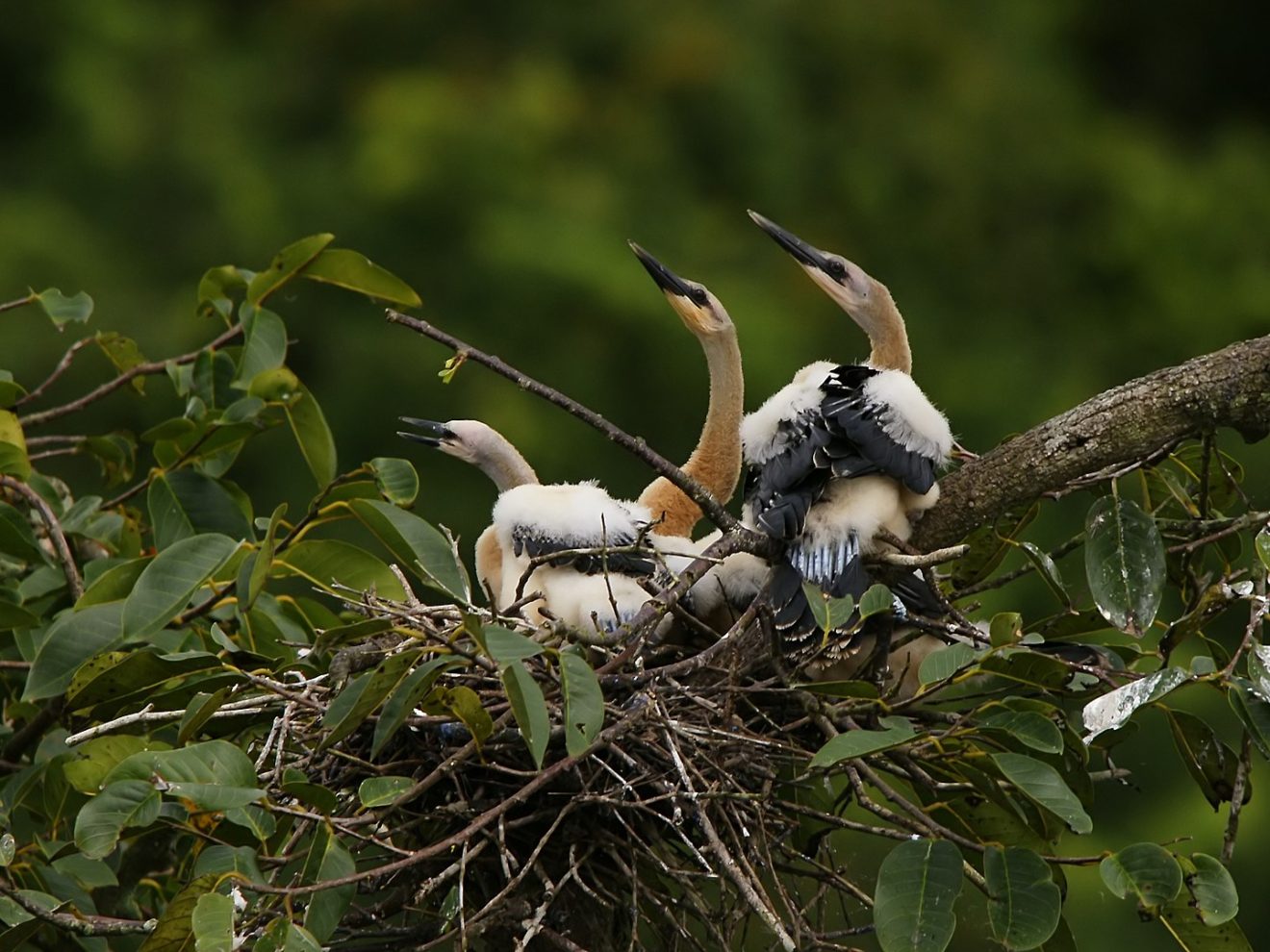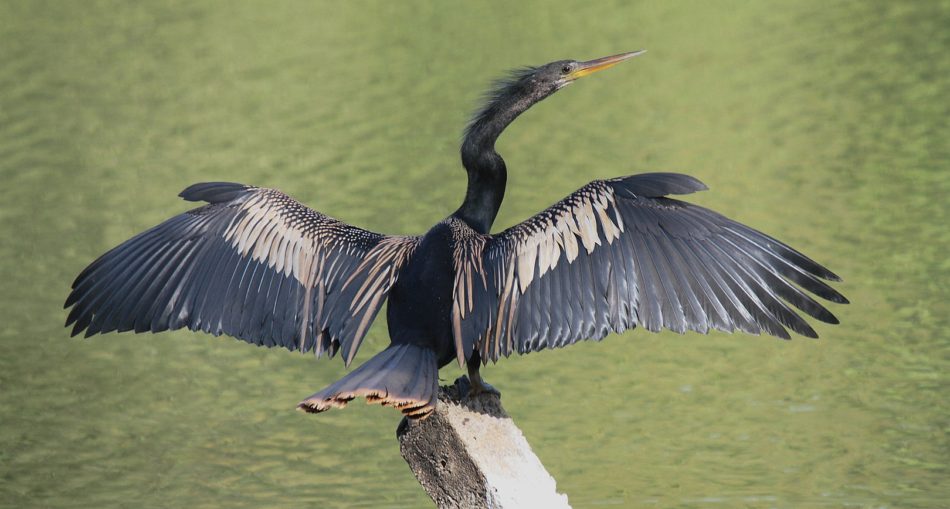The Anhinga (Anhinga anhinga) is a large water bird found in the warmer parts of the Americas. They are members of the darter family and are related to pelicans and cormorants. The word “Anhinga” comes from the Tupi language of Brazil and means snake bird or devil bird. They are also known by other names such as Darter, Water Turkey, and American Darter.
When in water, only its long neck appears above the surface, giving it the appearance of a snake, hence the name – Snakebird. These birds like chasing behind their prey for about several hours. They have wonderful swimming and diving abilities. Their body has water absorbent feathers that allow for smooth diving, a unique adaptive feature that is rare in birds. They can be found at the Buffalo Pond, Karanambu Ranch, here in Guyana.
Description Of The Anhinga
The Anhinga is a large bird that measures 29.5 – 37.4 inches (75 – 95 cm) in length, have a wingspan of about 3.7 feet (1.14 meters) and weigh between 2-3 – 3.0 lbs (1.04–1.35 kg) – the average being 2.7 lbs (1.22 kg). It has a long S-shaped neck and a long pointed bill. It has large wings with silver-white feathers on the top side. The male has grayish-black feathers with a greenish shine to them. The female has a tan head, neck, and chest, and a black stomach. Both the male and the female have long, fan-shaped tail feathers. When the anhinga is in its breeding plumage it has a blue ring around its eyes.
Habitat Of The Anhinga
Anhinga’s live all year round in southwest coastal areas of the United States, from North Carolina to Texas. They are also found in Central America, Mexico, Panama, and Cuba, and in South America from Colombia, Trinidad and Tobago, Guyana, Grenada and in the east of the Andes to Argentina. They live in tropical and subtropical areas. They prefer waters that are fresh or brackish, and can sometimes be found on coasts. They live near lakes, marshes, and mangrove swamps with tall trees and thick vegetation, and in shallow lagoons and bays.
Diet Of The Anhinga
Anhingas are carnivores and they primarily feed on slow-moving, small- to medium-sized wetland fish, as well as aquatic insects, crayfish, leeches, shrimps, frogs, frog eggs, tadpoles, salamanders, water lizards, small water snakes, and even young alligators and small terrapins (turtles).
Behavior Of The Anhinga
Anhingas are diurnal and solitary. They will nest with their species and other birds in loose colonies but do not associate with other anhingas aside from in nesting colonies. These birds are highly territorial, engaging in exaggerated displays when defending their nest site: spreading their wings and snapping their beak to threaten an intruder, leading to a fight if necessary, pecking each other on the neck and head. When they are in the water they spend most of their time fishing, otherwise, they will be found perched in trees. They often crawl out of the water to find a high perch so they can sun themselves. Anhingas will spread out their wings to sun themselves, which dries out their plumage, absorbing heat from the sun. They lose heat quickly in water as they have no layer of body feathers to provide insulation, thus, the sun’s heat helps them to maintain their body temperature.
Reproduction Of The Anhinga
Anhingas are monogamous, forming strong pair bonds, which last for life. During courtship, they perform flying displays, soaring towards their nest from a great height. The nest is built by both adults and is used then from year to year. 2 to 5 eggs are laid and incubation is for around 25 to 30 days, done by both parents. Chicks are naked and helpless when they hatch and may have some dark and white down along their sides. They are brooded for 12 days by both parents and remain in their nest for three weeks. Then they climb out of their nest onto a branch, and they fledge at about six weeks old. They stay for several more weeks with their parents before becoming independent and reach maturity when they are about 2 years old.

Anhinga juveniles By © Hans Hillewaert, CC BY-SA 3.0, https://commons.wikimedia.org/w/index.php?curid=11394965
Some Fun Facts About Anhinga’s
- Anhingas are usually quiet birds, but they do make vocalizations, consisting of clicks, rattles, grunts, and croaks.
- Anhinga parents first feed chicks by dripping regurgitated fish and fluid directly into their open bills. When the chicks are older, they will put their heads into their parents’ bills to get the food.
- If threatened, the chicks can drop into the water to swim away, and will later climb out of the water back into their nest.
- Male and female anhingas can easily be distinguished, as males have a black head and neck, while females have a golden-brown head and neck.
- Anhingas are often seen soaring high overhead. They are graceful fliers and can fly long distances without needing to flap their wings, similar to the flight of a turkey vulture.
- The vertebrae in an anhinga’s neck have a structure to allow the powerful stabs they need to make to spear fish using their sharp bill.
Anhinga’s In Guyana
Anhingas can be found at the Buffalo Pond, Karanambu Ranch, here in Guyana. As you would have read, it is a large waterbird that is found in the warmer parts of the Americas and goes by names such as Snakebird, Darter, American Darter. They also have wonderful swimming and diving abilities and mostly feeds on small to medium size fishes, reptiles and amphibians.
Article References:
- https://www.kaieteurnewsonline.com/2017/03/19/anhinga/
- https://www.audubon.org/field-guide/bird/anhinga
- http://www.animalplace.net/birds/anhinga-facts-characteristics-habitat-and-more/
- http://animalia.bio/anhinga
- https://en.wikipedia.org/wiki/Anhinga
- Main Image: By Wagner Machado Carlos Lemes – Imported from 500px (archived version) by the Archive Team. (detail page), CC BY-SA 3.0, https://commons.wikimedia.org/w/index.php?curid=71319940







